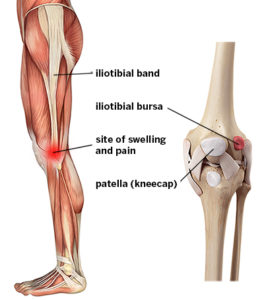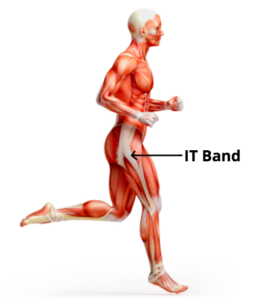Are you experiencing “IT band” pain? What is the cause?
The Iliotibial band (ITB) is a broad band of connective tissue that runs along the outside of the thigh, it extends from our lateral hip down to the outside of your knee. It is a passive stabilizer of the hip and lateral stabilizer for our knee. It is also the attachment point for a couple muscles in our hip. Due to faulty mechanics or overuse, the ITB can become stressed and lead to inflammation, irritation and pain. Typically, pain occurs at the knee or hip, but can occur anywhere along its path. An injury to the ITB can cause difficulty with daily activities or setbacks to training.

Due to the complexity of the cause(s) of pain in the ITB, it is helpful to break down the most common causes into internal and external factors. There is typically more than one factor at play, so a thorough assessment is key to starting a successful recovery:
- Internal Factors– Poor flexibility in the hip or thigh, weak gluteal musculature, poor running or lifting mechanics.
- External Factors– Improper footwear, improper orthotics, change in training intensity, change in training surface, or sudden increase in activity level.
Other common conditions associated with ITB pain include:
- Trochanteric Bursitis– This is often the result of increased rubbing of the ITB over the bursa on the outside of our hip. Pain can travel the length of the ITB and even down into the lower leg/calf. Typically caused by overuse or from a traumatic fall landing on the outside of the hip. Rest, stretching, and activity modification are key initial interventions to relieving the symptoms.
- ITB Syndrome– This is very common in runners. Weakness in the hips and lack of flexibility can lead to increased wearing and rubbing of the ITB over the bony prominences of the leg resulting in pain. Running and lifting mechanics are often poor as well and need to be addressed to prevent further ITB injury.
- Knee or Hip Pain– Sometimes the pain can be general, diffuse areas of our hip/knee joints and can be hard to determine exactly where they originate. Typically, the result of overuse with the combination the internal/external factors above.
- Lumbar Spine Radiculopathy– Pain in the ITB could be coming from nerves in our low back, known as lumbar radiculopathy. This is often difficult to tell apart from the other conditions above, it can be accompanied by numbness/tingling or even burning pain.
A couple of useful injury prevention activities include:
Stretching the muscles around the hips and knee, the ITB does not stretch but the muscle that attach to it do so focus on these areas. Also, listen to your body and gradually increase activity levels giving yourself time to recover and determine your tolerance to new activities. The use of a foam roller to address the areas of tightness can be a helpful adjunct to stretching. Physical therapy your Physical Therapist can perform a thorough examination and determine which factors are contributing to your pain and help develop a comprehensive, individualized exercise program to help you get back to your activities.
Blog researched and written by : Dr. Brandon Brym, PT, DPT.
